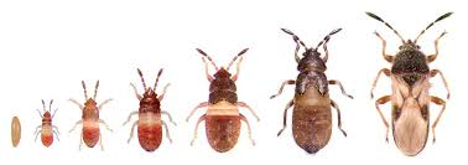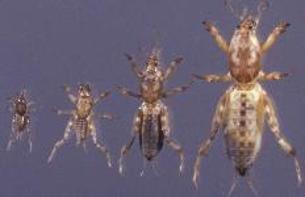- Caterpillars feed on grasses
- Mostly warmer season, but can occur year-round
- Chewing notches along leaves
- Ragged appearance
- “Windows” scraped into grass blades by more immature larvae
- Too small to chew and notch
- ¾ – 1 inch long
- Bright green frass (that is insect poop)!

Fall Armyworm
- Year-round pest, but populations build up in Fall
- Feed on all grasses, but prefer bermudagrass
- Green to brown
- 5 inches long
- Y on head
Striped Grass Looper
- Year-round pest, but populations build up in Fall

- Loop like inchworms
- Long and thin
- Cream to black color with narrow stripe down back
- More problematic in Bahia grass pastures
Chinch Bugs
- Most common turfgrass pest
- Active March – November
- Can be problematic year-round
- Incomplete metamorphosis

- Same mouthparts entire life
- Same feeding preference on grass sap entire life
- More challenging to control
- Leads to weed problems once grass dies back
- Monitor with dust buster vacuum
- High end landscape will treat if 1 chinch bug
- Moderate landscapes should adjust threshold to 10- 25 per square foot
Grubs
- Feed on roots

- Grass thins out
- Feels soft and spongy
- Scattered and irregular brown patches may occur
- Grass may peel back like roll of sod
- Look for creamy, white, C- shaped, beetle larvae
- Treatment thresholds vary
Mole Crickets
- Most common in St. Augustine, Bermuda, and Bahia

- Eggs deposited April – May, juveniles through August, and adults starting August – September
- Feed above and below ground
- Monitor surface tunneling
- Can do soap flush in turf
- 2 tbsp. dish soap with 2 gallons water
- Pour on 4 square foot area
- Wait three minutes for insects to come to surface
- Consider control with 2- 4 crickets per square foot
Tools: Vacuum and Soap Flush
A dust buster vacuum is a lawn technician’s best friend. The small vacuum can be used on a one square foot area of turf where damage is moving. Vacuum that turf section really well, and then dump the contents of the vacuum onto a light colored tray. Count the crawlies!
A soap flush using a couple gallons of water and two tablespoons of dish soap poured over a small section of turf will get critters to move up or float to the surface.
UF/IFAS Insect ID Lab
UF/IFAS has a lot of diagnostic services available! Start with your local county extension agent. If they cannot identify the insect, they will work with you to collect samples to send to the UF/IFAS Insect ID Lab in Gainesville. Or start with great photos sent to your local agent, and they will guide you from there! Here is a link to the lab in Gainesville: http://entnemdept.ufl.edu/insectid/
Insects are super important, and unfortunately, a lot of good ones are declining. That is why we ID! A really cool place to visit that has incredible insect collections is the Florida Museum of Natural History.
https://gardeningsolutions.ifas.ufl.edu/lawns/problems-and-solutions/lawn-insect-pests.html
 0
0






